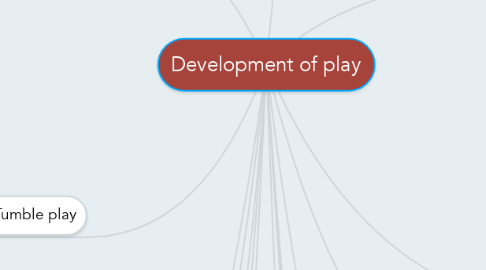
1. The Childs social world
1.1. • Becomes increasingly complicated and sophisticated with development • Impacts on and interacts with learning and cognitive development
2. Order of play
2.1. • Solitary Play • Parallel Play • Collaborative Play
3. Early peer interaction
3.1. 3-4 months - interest in peers emerges.
3.2. 6 months - overt communication with peers begins.
3.3. 12 months - Shared activity with peers, object centered.
3.4. 20-24 months - Imitation of peers behaviour.
3.5. Toddlers play - Parallel play, Toddler imitation.
3.6. Language play
3.6.1. 16-20 months- pretend play emerges
3.6.2. 18 months - 3 years - focus on social interaction takes over from object interaction. Specific friendships emerge.
3.6.3. 31 months - 3 years- Assignment of social roles in play.
3.6.4. Sign babbling language play with deaf infants.
3.7. Play criteria- flexibility, intrinsic motivation, positive effect, nonliterality. Krasnor and Pepler (1980)
3.7.1. The more criteria raters agree are present, the more likely activity is to be 'play'.
4. Sensorimotor play
4.1. • Characterises early infancy • Repetition of motor acts – e.g., Sucking their toes, dropping a spoon from a high chair – Imitation (particularly of parents) • Initially when parents are present and engaged with the task (e.g. washing up) • Toddlers will imitate acts when on their own
5. Theories of pre tense mental representation humour.
5.1. Humour and play • In play, language play or pretend play, then there are 2 necessary features – 1) Understanding how things are in reality or should be – 2) Intentionally subverting those understandings
5.2. Humour and Incongruity • Piaget (1962) – Incongruous Actions 1-2 – Incongruous Language 2 – Conceptual Incongruity 4 – Word Play 7
5.3. Early basis of humour is surprise about the physical and social world.
6. Rough and Tumble play
6.1. Rough and tumble play • Involves wrestling, grappling, rolling around on the floor, chasing… • Common in preschool years and middle childhood • Can look like real fighting – ‘we were only playing, miss!’ • Interviews with children and playground observation: rarely leads to real fighting (Schafer & Smith, 1996). • Bjorklund & Brown (1998) – Helps children understand social signals • Dominance hierarchy? – Argue modules may have evolved to process social information
7. Conflict
7.1. Three years to formal boot camp • Experiences of Conflict – Object struggles • Prosocial behaviour increases – Empathy, sharing, helping – Play and fantasy play increases in complexity – Children engage others in their pretend play – Again, links with ToM
7.2. Gender differentiation • Experiences of Conflict – Object struggles • Prosocial behaviour increases – Empathy, sharing, helping – Play and fantasy play increases in complexity – Children engage others in their pretend play – Again, links with ToM
7.3. Primary school gender differentiation • Lever (1978) – 10 -11 year old American children – Boys played in • Larger mixed-age groups • Competitive team games; roles and structure • Competition and leadership roles emphasised – Girls played in • Smaller groups or same age pairs • Emphasis on intimacy and exclusiveness
8. What is play?
8.1. A behaviour which is enjoyable, done for its own sake, but which does not have any obvious, immediate purpose. (Slater and Bremner, 2011)
9. Examples go early play
9.1. An infant repeatedly dropping an object.
9.2. An infant banging objects together to make a noise.
9.3. An infant babbling and cooing to themselves.
9.4. An infant laying a dolly down in 'bed'
10. Understanding play and its theories
10.1. Play is action for its own sake vs work that is for a reward or requirement.
10.2. Current perspective on play as a vehicle for learning, skill acquisition, and development. Therefore worthy and necessary of incorporating in educational programmes.
11. Historical theories of play
11.1. • Surplus Energy (Berlyne, 1969) • Recreational or Relaxation (Patrick, 1916) • Practice (Groos,1901) – Experimental Play (games with rules) – Socioeconomic Play (rough and tumble play) – Imitative, social, family games (Dramatic Play)
12. Contemporary theories
12.1. More focused on play as supporting and driving development in cognition, communication, and the uses of symbols (Mellou, 1994)
13. Theories of play
13.1. What do we mean by 'playful' behaviour'?
13.1.1. Fagan (1974), functional approach, defines play as not having an obvious goal or benefit.
13.1.2. – Structural approach • Aims to describe the sorts of behaviour that only occur in play (e.g. laughter and open-moth play face) • Behaviours that are repeated, exaggerated or reordered • Exploration is different from play
14. Attachment and play
14.1. Play- an attachment perspective
14.1.1. Attachment as the bond between a caregiver and infant
14.1.2. A secure attachment supports the child’s exploration of the physical and social environment
14.1.3. Insecure attachment will therefore inhibit play and play development
14.2. Attachment and play
14.2.1. • Secure • Avoidant • Ambivalent/Resistant • Disorganized • Resistant focus on caregiver limits the play opportunities for the child. • Secure children exhibit more complex play (Belsky, 1984).

